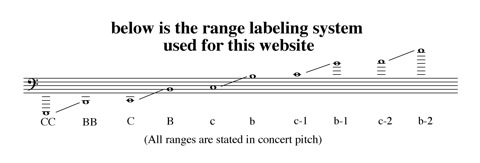EXPLANATION OF PROVIDED MUSIC DATA
The individual information page provided for each composition begins with a list of various factual data. The data is presented in the following order: title, composer, instrumentation(s), copyright date, range, difficulty, publisher, selling price (in U.S. Dollars), recorded by (if a commercial recording has been made, the artist and record label are listed here), and other information (such as where the piece was premiered, who commissioned it, and to whom the work is dedicated).
DIFFICULTY RATINGS have been determined by Neal Corwell, and are stated in roman numerals and based on the rating system given below. Many pieces do not fit easily into one of the categories, and therefore are stated as being between two levels. For example, a rating such as III-IV, indicates the difficulty is somewhere between the 3rd and 4th (high school and college) levels of difficulty.
I = Beginner: limited range and rhythmic/technical requirements.
II = Intermediate: two-three years of instruction. fairly limited range and no technical demands greater than simple syncopations and sixteenth-note patterns.
III = High school, pre-college: two & half octave range. More rhythmic complexity and syncopation, and possibly moderate multiple-tonguing.
IV = College: range from pedal tones up to demanding high range. May include some of the following challenges: increased endurance requirements, rhythmic complexity, multi-meters, angular melodic lines, avant-garde techniques, dynamic range extremes, and difficult multiple tonguing.
V = Advanced college/professional: Difficulties will include extreme demands in some or all of the following areas: range, endurance, rhythmic complexity, tonguing, and advanced avant-garde techniques.
RANGES are generally given for solo parts only. Note names are given in concert pitch, with the lowest note stated first, and the highest note stated next . If optional ossia passages give the soloist the option of reducing or increasing the range, that is indicated. The chart below illustrates the octave notation system being used.